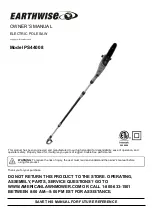
4
c)
Lower guard should be retracted manually only for special cuts such as
“plunge cuts” and “compound cuts.” Raise lower guard by retracting handle
and as soon as blade enters the material, the lower guard must be released.
For all other sawing, the lower guard should operate automatically.
d)
Always observe that the lower guard is covering the blade before placing saw
down on bench or floor.
An unprotected, coasting blade will cause the saw to
walk backwards, cutting whatever is in its path. Be aware of the time it takes for
the blade to stop after switch is released.
Additional Specific Safety Instructions for Circular Saws
WARNING:
Do not use abrasive wheels or blades.
WARNING:
Do not use water feed attachments.
•
Use clamps or another practical way to secure and support the workpiece
to a stable platform.
Holding the work by hand or against your body leaves it
unstable and may lead to loss of control.
•
Keep your body positioned to either side of the blade, but not in line with the
saw blade.
Kickback could cause the saw to jump backwards (Refer to
Causes
and Operator Prevention of Kickback
and
Kickback
).
•
Avoid cutting nails. Inspect for and remove all nails from lumber before
cutting.
•
Accessories must be rated for at least the speed recommended on the tool
warning label.
Wheels and other accessories running over rated speed can fly
apart and cause injury. Accessory ratings must always be above tool speed as
shown on tool nameplate.
• Always make sure the saw is clean before using.
• Stop using this saw and have it properly serviced if any unusual noise or
abnormal operation occcurs.
• Always be sure all components are mounted properly and securely before using
tool.
• Always handle the saw blade with care when mounting or removing it.
• Always wait until the motor has reached full speed before starting a cut.
• Always keep handles dry, clean and free of oil and grease. Hold the tool firmly
with both hands when in use.
• Always be alert at all times, especially during repetitive, monotonous operations.
Always be sure of position of your hands relative to the blade.
Kickback is the result of saw misuse and/or incorrect operating procedures or
conditions and can be avoided by taking proper precautions as given below:
a)
Maintain a firm grip with both hands on the saw and position your arms to
resist kickback forces. Position your body to either side of the blade, but not
in line with the blade.
Kickback could cause the saw to jump backwards, but
kickback forces can be controlled by the operator, if proper precautions are taken.
b)
When blade is binding, or when interrupting a cut for any reason, release the
trigger and hold the saw motionless in the material until the blade comes to
a complete stop. Never attempt to remove the saw from the work or pull the
saw backward while the blade is in motion or kickback may occur.
Investigate
and take corrective actions to eliminate the cause of blade binding.
c)
When restarting a saw in the workpiece, center the saw blade in the kerf and
check that saw teeth are not engaged into the material.
If saw blade is binding,
it may walk up or kickback from the workpiece as the saw is restarted.
d)
Support large panels to minimize the risk of blade pinching and kickback.
Large panels tend to sag under their own weight. Supports must be placed under
the panel on both sides, near the line of cut and near the edge of the panel.
e)
Do not use dull or damaged blades.
Unsharpened or improperly set blades
produce narrow kerf causing excessive friction, blade binding and kickback.
f)
Blade depth and bevel adjusting locking levers must be tight and secure
before making cut.
If blade adjustment shifts while cutting, it may cause binding
and kickback.
g)
Use extra caution when making a “plunge cut” into existing walls or other
blind areas.
The protruding blade may cut objects that can cause kickback.
LOWER GUARD SAFETY INSTRUCTIONS
a)
Check lower guard for proper closing before each use. Do not operate the saw
if lower guard does not move freely and close instantly. Never clamp or tie the
lower guard into the open position.
If saw is accidentally dropped, lower guard
may be bent. Raise the lower guard with the retracting handle and make sure it
moves freely and does not touch the blade or any other part, in all angles and
depths of cut.
b)
Check the operation of the lower guard spring. If the guard and the spring
are not operating properly, they must be serviced before use.
Lower guard
may operate sluggishly due to damaged parts, gummy deposits, or a build-up of
debris.
Summary of Contents for DW995K
Page 1: ...DWE575 XE 184 mm 7 1 4 CIRCULAR SAW INSTRUCTION MANUAL ...
Page 2: ......
Page 17: ......
Page 18: ......
Page 19: ......






































